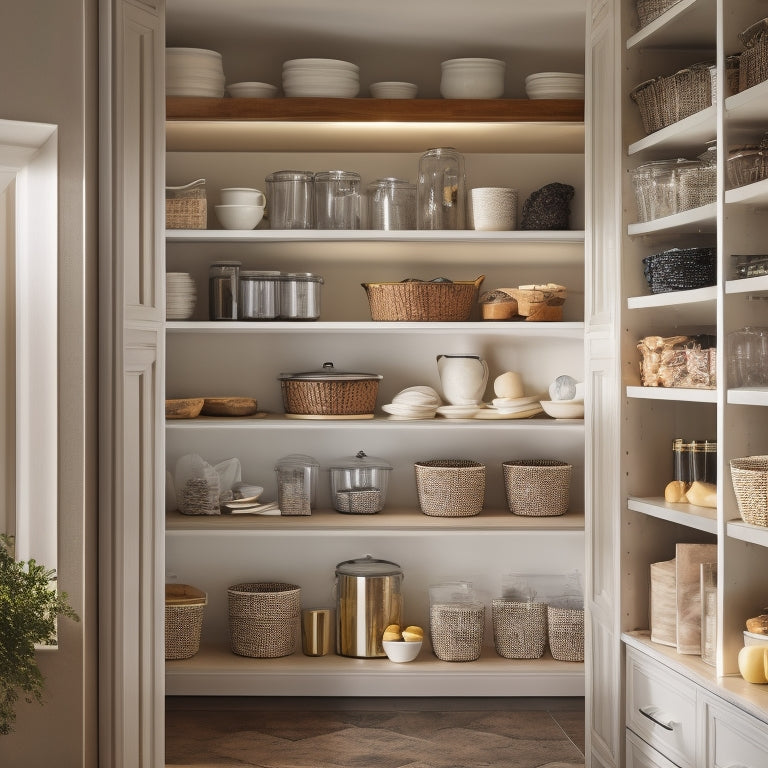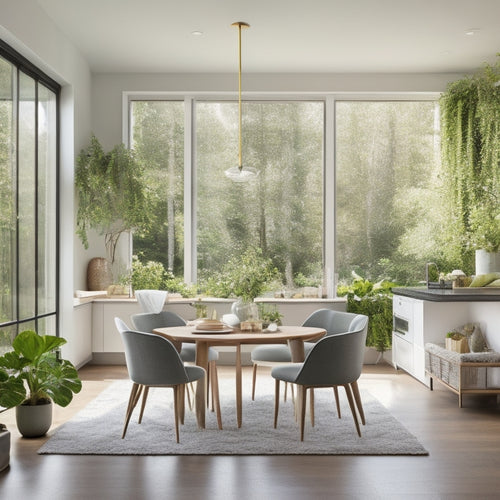
5 Simple Ways to Declutter Your Pantry Clear Your Mind
Share
You're tired of feeling overwhelmed by your cluttered pantry. It's time to take control! Start by purging expired or spoiled food, and categorize similar items together to create a sense of order. Assign a home for each item, maximizing your pantry's storage capacity with vertical shelves and labels. Schedule regular maintenance to maintain your sense of calm and control. By following these simple steps, you'll be well on your way to a clutter-free pantry that clears your mind. And, as you uncover the secrets to a more organized you, you'll discover even more ways to simplify your space and streamline your life.
Key Takeaways
• Purge expired or spoiled food items to reduce waste and create a fresh start in your pantry.
• Categorize and group similar items together to create a sense of order and make meal planning easier.
• Assign a designated spot for each item to maintain organization and ensure everything has its place.
• Utilize vertical storage space by using stackable shelves or wall-mounted baskets to maximize your pantry's storage capacity.
• Schedule regular pantry maintenance to maintain a sense of calm and control, and to ensure your pantry stays organized.
Purge the Unnecessary Items
Get rid of expired or spoiled food, as well as any opened or partially used packets that are beyond their prime, taking a critical eye to your pantry's contents. It's important to acknowledge that food waste is a significant problem, and holding onto expired or spoiled items contributes to it.
Be honest with yourself - when was the last time you used that can of beans or opened that bag of flour? If it's been months, it's likely time to let it go.
You might feel an emotional attachment to certain items, but remember that keeping them won't bring back memories or recreate a special moment. It's okay to let go of items that no longer serve a purpose.
Take a deep breath, and remove anything that's past its expiration date or no longer usable. This step is vital in decluttering your pantry, and it will make a significant difference in the long run. You'll reduce food waste, create space, and make meal planning more efficient.
Categorize and Group Similar Items
Now that you've purged your pantry of unnecessary items, categorize and group similar items together, such as grains, canned goods, and baking supplies, to create a sense of order and make meal planning more essential. This step is vital in creating a functional pantry that sparks joy.
By grouping similar items, you'll be able to see what you have, what you need, and what you can get rid of.
Create 'food zones' in your pantry, where you designate specific areas for specific types of food. For example, you can have a zone for breakfast items, a zone for snacks, and a zone for baking supplies.
Within each zone, use a labeling system to identify the contents of each shelf or bin. This will make it easy to find what you need when you need it.
Assign a Home for Each Item
With your pantry categorized and grouped, it's time to designate a specific spot for each item, ensuring everything has a designated place where it will be easy to find and access when needed. This is where zone designation comes in – assign specific areas of your pantry to specific categories, like baking supplies or snacks.
Within each zone, create a labeling system to identify what's stored in each container or shelf. This will help you quickly locate what you need and prevent clutter from building up again.
As you assign a home for each item, consider the frequency of use and the size of the item. Store heavy or bulky items at the bottom, and lighter items towards the top. Make sure the most frequently used items are easily accessible, and less-used items are stored towards the back or on higher shelves.
Utilize Vertical Storage Space
You can maximize your pantry's storage capacity by making the most of its vertical space, taking advantage of every inch from floor to ceiling to store less frequently used items or bulky containers. This will help you create a more organized and functional pantry.
To optimize your shelves, consider installing stackable shelves or adjustable shelving units. This will allow you to customize your storage space according to your needs.
You can also use wall-mounted baskets or shelves to store items like spices, oils, or snacks.
Don't forget to maximize corners by using corner shelves or carousels. These will help you make the most of the often-wasted space in the corners of your pantry.
By utilizing vertical storage space, you'll be able to store more items in a smaller area, keeping your pantry clutter-free and easy to navigate.
With a little creativity and planning, you'll be able to create a pantry that's both functional and visually appealing.
Schedule Regular Pantry Maintenance
To keep your pantry organized and clutter-free, set a regular maintenance schedule to make sure everything stays in its assigned place. This will help you maintain the sense of calm and control you've achieved through decluttering.
Schedule a weekly Pantry Reflection to review what you have, what you need, and what you can get rid of. This will help you stay on top of expiration dates, notice patterns in your consumption, and plan your meals more effectively. Set a specific day and time for your Pantry Reflection, and stick to it. This will create a Maintenance Rhythm that becomes second nature to you.
During your Pantry Reflection, take stock of what's running low, what's expired, and what can be donated or repurposed. Take a few minutes to wipe down shelves, tidy up labels, and make sure everything is in its designated spot.
Frequently Asked Questions
How Do I Handle Expired or Spoiled Food During the Decluttering Process?
When decluttering, you'll inevitably encounter expired or spoiled food. Properly dispose of it to maintain food safety, and consider composting to reduce waste; then, take a deep breath and let go of the guilt - it's a normal part of the process!
Can I Reuse Old Containers or Should I Invest in New Ones?
You can definitely reuse old containers, but consider upcycling them for a unique look or investing in new ones for aesthetic uniformity, ensuring your pantry's visual harmony and making you feel more organized and in control.
What if I Have Limited Pantry Space Due to Awkward Shelving?
When dealing with awkward shelving, you're gonna need to get creative! You'll want to optimize your layout by using stackable shelves or baskets, and maximize those pesky corners with carousels or lazy susans to make the most of your space.
How Often Should I Rotate My Food Stock to Ensure Freshness?
'Did you know 40% of food waste comes from expired or spoiled food? You can avoid this by implementing a Stock Turnover system, tracking your Freshness Calendar to make sure you consume oldest items first, and rotating your stock every 1-2 weeks for best freshness.'
Are There Any Pantry Organization Systems Suitable for Renters?
You'll find perfect pantry organization systems as a renter by opting for modular shelves that are easy to assemble and disassemble, and adhesive hooks that won't damage walls, giving you flexibility and peace of mind.
Related Posts
-

Family Harmony Achieved: Doral Home Renovation Unveiled
We designed our Doral home renovation around a simple yet powerful idea: that a unified, open space can bring our fam...
-

Revamp Your Kitchen Storage With These Tips
A well-organized kitchen storage system is essential to a clutter-free and functional cooking space. To enhance your ...

